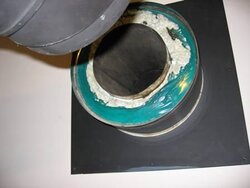I am not sure if I used the right term so please correct me if I am wrong.
Last winter because every now and then we'd get a whiff of something "creosotey" and when I would sniff the cold pipe, it was the strongest one of the screws that attached the double wall to the thimble. I ended up wrapping the space between the double wall ending and the entrance to the thimble with a gasket and that took care of it.
We cleaned out our chimney for the first time this past weekend (installed spring 2009 so last winter was our first burn). When the installers put in the connection to our thimble (double wall pipe to thimble entrance) one of the self tapping screws didn't bite and the connector got bent at that location. When we pulled the inside pipe to clean it I noticed some of the Selkirk chimney "plastic protection" had melted (see pic). The gasket had a light burn mark at that area when I unwrapped it to clean the chimney.
When reinstalling, we bent it pipe back flush to the double wall and didn't install the screw there this time. My question is, should we be concerned about this melting? The good news is that all we brushed out was black coffee grounds - about half an ice cream container full for a 17 ft run. Our wood is dryer this year.
Thanks for any help / suggestions. I learn everything from this site!
~~~~~~~~~~~~~~~~
Updated:
I guess I wasn't clear about the plastic protection. The plastic is the green part in the picture and I think is factory installed and meant to "keep the insulation protected" (during the install only?), but not sure. It covered the now visible insulation. The chimney and thimble were installed by the previous owners which can date it anywhere from a 1994 to 1999 install.
Last winter because every now and then we'd get a whiff of something "creosotey" and when I would sniff the cold pipe, it was the strongest one of the screws that attached the double wall to the thimble. I ended up wrapping the space between the double wall ending and the entrance to the thimble with a gasket and that took care of it.
We cleaned out our chimney for the first time this past weekend (installed spring 2009 so last winter was our first burn). When the installers put in the connection to our thimble (double wall pipe to thimble entrance) one of the self tapping screws didn't bite and the connector got bent at that location. When we pulled the inside pipe to clean it I noticed some of the Selkirk chimney "plastic protection" had melted (see pic). The gasket had a light burn mark at that area when I unwrapped it to clean the chimney.
When reinstalling, we bent it pipe back flush to the double wall and didn't install the screw there this time. My question is, should we be concerned about this melting? The good news is that all we brushed out was black coffee grounds - about half an ice cream container full for a 17 ft run. Our wood is dryer this year.
Thanks for any help / suggestions. I learn everything from this site!
~~~~~~~~~~~~~~~~
Updated:
I guess I wasn't clear about the plastic protection. The plastic is the green part in the picture and I think is factory installed and meant to "keep the insulation protected" (during the install only?), but not sure. It covered the now visible insulation. The chimney and thimble were installed by the previous owners which can date it anywhere from a 1994 to 1999 install.


